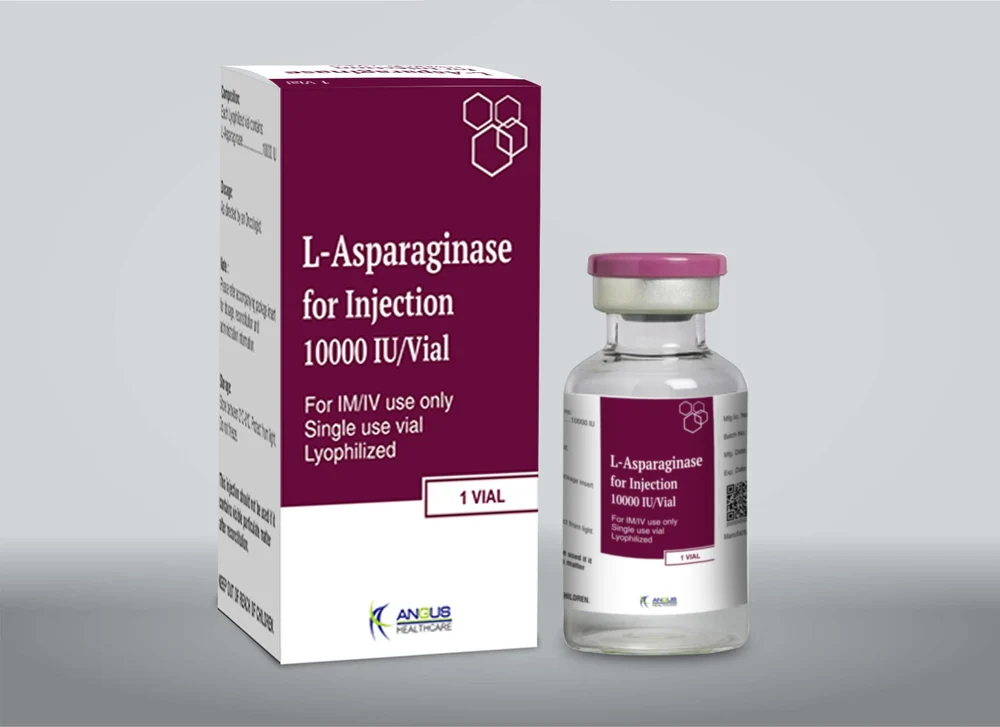💊 DESCRIPTION
L-Asparaginase is an enzyme-based cytotoxic agent derived from Escherichia coli (E. coli), used in the treatment of certain hematologic malignancies. It is supplied as a lyophilized powder for intravenous (IV) or intramuscular (IM) administration after reconstitution.
- Form: Powder for Injection
- Strength: 10,000 KU (Kunits Units) per vial
- Route: IV or IM (never intrathecal)
- Drug Class: Antineoplastic enzyme
- Indications:
- Acute Lymphoblastic Leukemia (ALL) – especially in pediatric and adolescent patients
- Used during induction and consolidation therapy phases
- Occasionally used in lymphoblastic lymphoma or other protocols
✅ ADVANTAGES
- Selectively targets leukemic cells that lack asparagine synthetase
- Reduces need for more toxic chemotherapy during certain phases
- Can achieve rapid tumor cell apoptosis
- Used in multi-drug regimens with good clinical outcomes in ALL
- Available in various strengths for dose flexibility
🌿 NATURE
- Mechanism of Action:
- Catalyzes the hydrolysis of L-asparagine into L-aspartic acid and ammonia
- Leukemia cells rely on external L-asparagine and undergo apoptosis when it’s depleted
- Normal cells can synthesize L-asparagine and are less affected
- Acts primarily in the G1 phase of the cell cycle
- Not a conventional cytotoxic — classified as an enzyme therapy
⚠️ PRECAUTIONS
- Hypersensitivity reactions (can be severe):
- Risk of anaphylaxis especially with E. coli–derived formulations
- Test dose or premedication may be used in some protocols
- Pancreatitis:
- Monitor for abdominal pain and elevated amylase/lipase
- Coagulation disorders:
- Can cause bleeding or thrombosis due to suppression of clotting factors
- Hepatotoxicity:
- Elevated liver enzymes, bilirubin; monitor liver function
- Hyperglycemia:
- Especially in patients also receiving corticosteroids
- Neurotoxicity:
- Rare, may cause lethargy, confusion, or seizures
- Do not administer intrathecally – fatal outcomes reported
🧊 STORAGE
- Before reconstitution:
- Store at 2–8°C (refrigerator)
- Protect from light
- Do not freeze
- After reconstitution:
- Use immediately when possible
- May be stored briefly at 2–8°C (consult specific manufacturer guidelines)
- Discard if discolored or if particles are visible
👨⚕️ PATIENT ADVICE
- Inform your doctor if you have a history of:
- Allergies, pancreatitis, liver disease, diabetes, or clotting problems
- Report immediately:
- Fever, rash, difficulty breathing, or swelling (possible allergic reaction)
- Severe stomach pain, nausea, vomiting (pancreatitis)
- Easy bruising or bleeding
- Unusual fatigue or jaundice
- Avoid alcohol and injury-prone activities
- You may need frequent blood tests to monitor:
- Liver function, blood sugar, coagulation profile, amylase/lipase
- Use effective contraception during and after treatment
📦 PACKAGING
- Primary Packaging:
- Glass vial with 10,000 KU lyophilized white to off-white powder
- Rubber stopper and flip-off aluminum cap
- Secondary Packaging:
- Outer carton with leaflet
- Label includes:
- Product name: L-Asparaginase 10,000 KU
- Batch number and expiry date
- Storage instructions
- “Cytotoxic – Handle with care” warning

